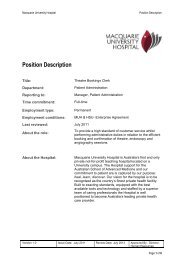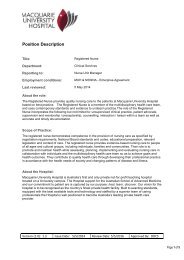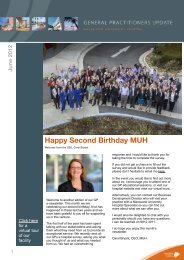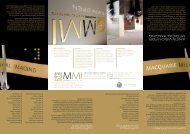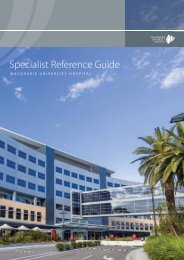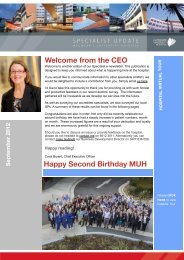Plenary Oral Presentations - Macquarie University Hospital
Plenary Oral Presentations - Macquarie University Hospital
Plenary Oral Presentations - Macquarie University Hospital
Create successful ePaper yourself
Turn your PDF publications into a flip-book with our unique Google optimized e-Paper software.
16 th International Meeting of the Leksell Gamma Knife ® SocietyMarch 2012, Sydney, AustraliaVA-77Mechanism of cyst formation and enlargement followinggamma knife surgery for arteriovenous malformationTakashi Shuto, Shigeo Matsunaga, Makoto OhtakeYokohama Rosai <strong>Hospital</strong>Objective: This study retrospectively analyzed the clinical characteristics of patients who presentedwith cyst formation following gamma knife surgery (GKS) for arteriovenous malformation (AVM),and mainly discusses the mechanism of cyst enlargement.Methods: Twelve male and five female patients aged 17 to 47 years (mean 28.7 years) were retrospectivelyidentified among 750 patients who underwent GKS for AVM at our institution. The calculatednidus volume, prescription dose to the nidus margin, timing of occurrence of neuroimaging change,follow-up imaging of cysts, findings during surgery, and pathological findings of the cyst wall andassociated granulomatous lesions were investigated.Results: Expanding hematoma was associated with cyst formation in 4 patients. The mean nidusvolume at the time of GKS was 10.1 ml (0.1-26.7 ml), and the mean prescription dose at the nidusmargin was 20.3 Gy (18-28 Gy). Complete obliteration of nidus was obtained in 12 patients, partialobliteration in 4, and no change in 1. Cyst formation was detected at 2.6-15 years (mean 6.9 years)after GKS. Two patients underwent craniotomy for cyst opening and removal of the incompletelyobliterated nidus, and two received placement of Ommaya reservoir. Spontaneous regression of thecyst was observed in one patient. Serial magnetic resonance (MR) imaging was performed in the other15 patients because the cyst showed unchanged size or remained asymptomatic. Histological examinationof cyst wall revealed linear deposits of hemosiderin with gliosis, but no evidence of fresh bleedingin the cyst wall. Histological examination of the enhanced lesion on MR imaging demonstrateddegenerated nidus with infiltration of inflammatory cells and old hemorrhage, and granulation tissuewith chronic hemorrhage from the newly developed capillary vessels.Conclusions: Cysts developing after GKS for AVM enlarge mainly due to repeated minor bleedingfrom angiomatous lesions developing within the degenerated nidus or adjacent brain. The optimaltreatment for such cysts is wide opening with removal of the angiomatous lesion through craniotomy.74



